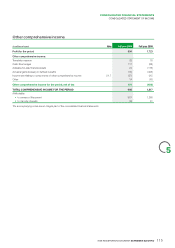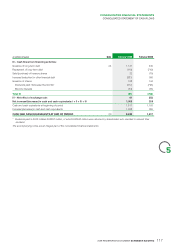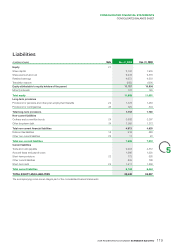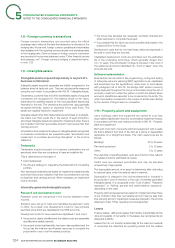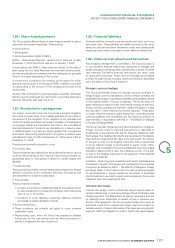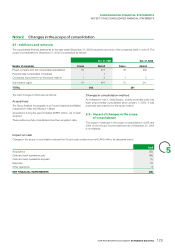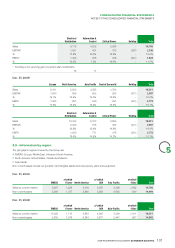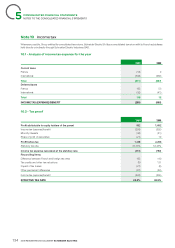APC 2009 Annual Report Download - page 127
Download and view the complete annual report
Please find page 127 of the 2009 APC annual report below. You can navigate through the pages in the report by either clicking on the pages listed below, or by using the keyword search tool below to find specific information within the annual report.
2009 REGISTRATION DOCUMENT SCHNEIDER ELECTRIC 125
CONSOLIDATED FINANCIAL STATEMENTS
5
NOTES TO THE CONSOLIDATED FINANCIAL STATEMENTS
payments are recognised as an expense on a straight-line basis
over the lease term.
Borrowing costs
In accordance with IAS23 R – Borrowing Costs (applied as of
January 1, 2009), borrowing costs that are directly attributable to
the acquisition, construction or production of a qualifying asset are
capitalised as part of the cost of the asset when it is probable that
they will result in future economic benefi ts to the entity and the costs
can be measured reliably. Other borrowing costs are recognised as
an expense for the period. Prior to January 1, 2009, borrowing costs
were systematically expensed when incurred.
1.11 - Impairment of assets
In accordance with IAS36 – Impairment of Assets – the recoverable
amount of long-lived assets is assessed as follows:
•all depreciable and amortisable property, plant and equipment
and intangible assets are reviewed at each balance sheet date
to determine whether there is any indication that the asset may
be impaired. Indications of impairment are identifi ed on the basis
of external or internal information. If such an indication exists, the
Group tests the asset for impairment by comparing its carrying
amount to the higher of fair value less costs to sell and value in
use;
•non-amortisable intangible assets and goodwill are tested for
impairment at least annually and when there is any indication that
the asset may be impaired.
Value in use is determined by discounting estimated future cash
fl ows that will be generated by the tested assets, generally over
a period of not more than fi ve years. Estimated future cash fl ows
are based on management’s economic assumptions and operating
forecasts. The discount rate corresponds to Schneider Electric’s
weighted average cost of capital (WACC) at the measurement
date plus a risk premium depending on the region in question. The
Group’s WACC stood at 8.1% at December 31, 2009 compared with
8.2% at December31,2008. This rate is based on (i) a long-term
risk-free interest rate of 3.9%, corresponding to the average interest
rate for 10year OAT treasury bonds over the past few years, (ii) the
average premium applied to fi nancing obtained by the Group in the
fourth quarter of 2009, and (iii) the weighted country risk premium for
the Group’s businesses in the countries in question. The perpetuity
growth rate was 2% in 2009, unchanged from the previous year.
Impairment tests are performed at the level of the cash-generating
unit (CGU) to which the asset belongs. A cash-generating unit
is the smallest group of assets that generates cash infl ows that
are largely independent of those cash fl ows from other assets or
groups of assets. At Schneider Electric, CGUs generally correspond
to the Operating Divisions (Europe, North America, International
and Asia-Pacific) and Business Units , customised Sensors &
Technologies (CST), Building Automation (BA) and Critical Power
& Cooling Services (CPCS). The CGUs’ value in use has been
determined on the basis of the following WACC: 8.1% for Europe,
8.5% for North America, 8.3% for Building Automation, 9.1% for
Critical Power & Cooling Services and 8.2% for customised Sensors
& Technologies.
Goodwill is allocated to a CGU when initially recognised . The
allocation is made on the basis used to track the performance
of Group operations and to assess the benefits derived from
the synergies of the business combination. As a result of the
organizational changes effective January 1, 2010, the allocation of
goodwill has been modifi ed to refl ect the new operating segments
defi ned in accordance with IFRS8. This modifi cation will not have
any impact on asset impairment.
If the recoverable amount of an asset or CGU is lower than its
carrying amount, an impairment loss is recognised . To the extent
possible, impairment losses on CGUs comprising goodwill are
recorded as a deduction from goodwill.
1.12 - Non-current financial assets
Investments in non-consolidated companies are classified in
available-for-sale fi nancial assets. They are initially recorded at cost
and subsequently measured at fair value, when fair value can be
reliably determined.
The fair value of equity instruments quoted in an active market may
be determined reliably and corresponds to the quoted price on the
balance sheet date (Level 1 input as described in the amendment to
IFRS7 - Improving Disclosures about Financial Instruments).
In cases where fair value can not be reliably determined (Level 3
inputs), the instruments are measured at cost net of any accumulated
impairment losses. The recoverable amount is determined by
reference to the Group’s equity in the entity’s underlying net assets
and the entity’s expected future profi tability and business outlook.
This rule is applied in particular to equity instruments that do not have
a quoted market price in an active market.
Changes in fair value are accumulated in equity under “Other
reserves” up to the date of sale, at which time they are recognised
in the income statement. unrealised losses on assets that are
considered to be permanently impaired are recorded under “Finance
costs and other fi nancial income and expense, net”.
Loans, recorded under “Other financial assets”, are carried at
amortised cost and tested for impairment if there is any indication
that their recoverable amount may be less than their carrying amount.
Long-term fi nancial receivables are discounted when the impact of
discounting is material.


